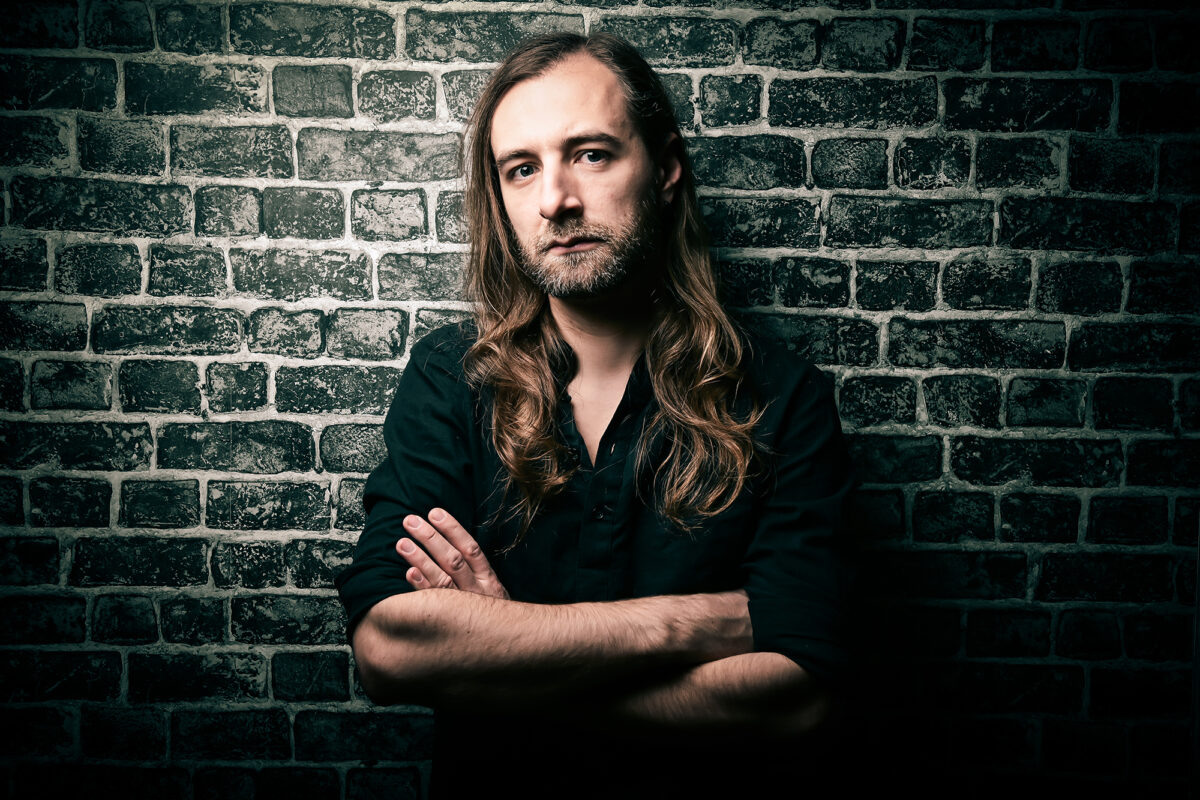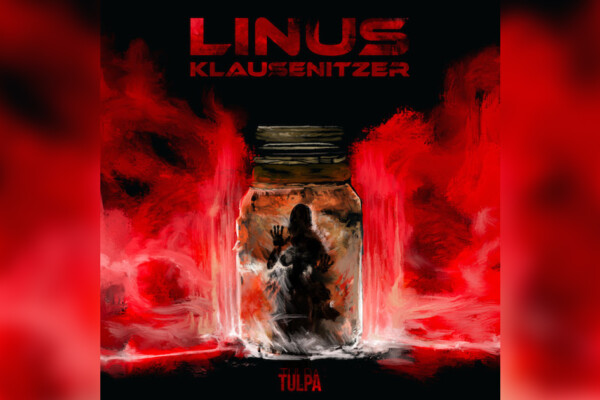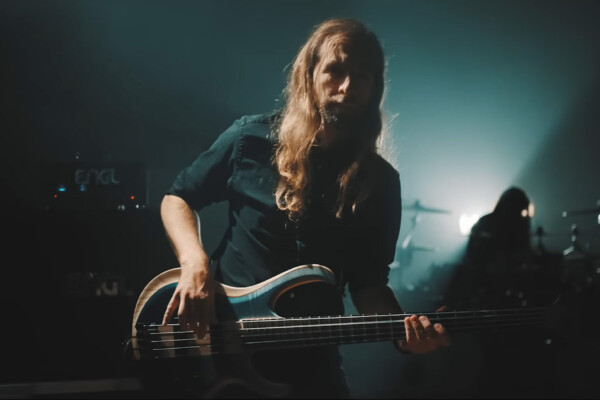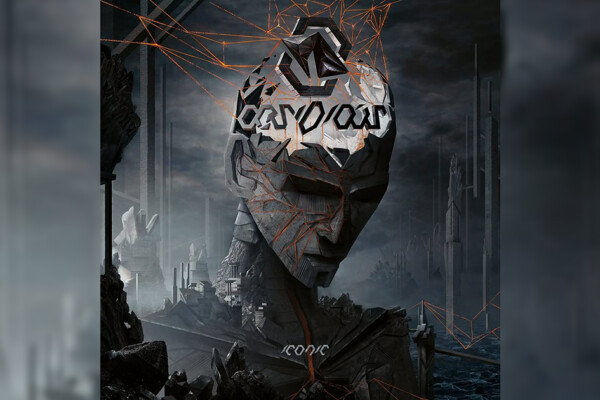Tulpa: An Interview with Linus Klausenitzer

The use of the fretless bass in metal has been on the rise thanks to a few key players, and you can’t make a list of those players without Linus Klausenitzer. A member of Obsidious and Alkaloid (as well as a former member of Obscura), he utilizes his technical prowess and melodic sensibilities to craft captivating bass lines and mesmerizing solos. The seasoned player has also lent his phenomenal six-string fretless to plenty of other projects, but this year marks a first for him.
 He just released his first solo record, called Tulpa. The ten-song collection is a concept album inspired by a 150-year-old book that tells the story of an Austrian lord who attempts to create artificial humans through alchemy. Each track explores one of the ten beings to create an incredible soundtrack of melodic death metal. Klausenitzer, who wrote all the music and lyrics, is joined by fellow musicians like Hannes Grossmann, Roland Grapow, Vanesa Jalife, and more to complete his vision.
He just released his first solo record, called Tulpa. The ten-song collection is a concept album inspired by a 150-year-old book that tells the story of an Austrian lord who attempts to create artificial humans through alchemy. Each track explores one of the ten beings to create an incredible soundtrack of melodic death metal. Klausenitzer, who wrote all the music and lyrics, is joined by fellow musicians like Hannes Grossmann, Roland Grapow, Vanesa Jalife, and more to complete his vision.
The album was recorded with his brand new Ibanez BTB, which is another first. It’s the first Ibanez bass to feature a stainless steel fingerboard.
In this interview, we go deep on the bassist’s new album, writing concept, new bass, and more.
Tulpa is available now on CD, vinyl and as a digital download (iTunes and Amazon MP3). Klausenitzer has also launched Behind the Glass, a video lesson series on how he makes an album.
Tulpa is a concept album based on the 1873 book “Die Sphinx” by Emil Besetzny. How did this even come about?
I’m a bass player, first of all. When I started to think about being a musician, bass playing was the thing that I wanted to do.
And then you know how it is: you grow older, you have more interests. The lyrical part was always something that other people took care of. It was never something I had to learn until I had to make my solo record now because there was no singer that wanted to make the lyrics. To be honest, I’m not a very lyrics-focused person. First of all, English is not my mother language, so I think it touches American or English speaking people more to hear English lyrics than most Germans. Anyway, it’s my solo record so I felt an obligation to write the lyrics.
I thought about all the records that I have where the lyrics mean something to me. I always really liked concept albums and I especially liked Bruce Dickinson’s The Chemical Wedding. When I was 16, I listened to that album all the time. I went through the booklet and all the alchemy related images and topics got me.
Music is always based on influences, so I thought “Why not go back and see if I can find something in that field of alchemy where I feel inspired again to read about it?” I Googled and Googled, went through countless weird, bizarre alchemy related forums, weird YouTube videos, and weird conspiracy people. Then I found a video about these 10 creatures.
It was just like a sidebar in a video about that story, but then I got curious and I found out that it’s a book from I think 1873 or something like that. Because it’s an historical book it was archived in Munich in Germany and they made a digital version of it that is still online. I read that whole thing.
I never read a book that is so old, so it was kind of interesting to get into the old German language, which made it more fun to read. I got into the story and got fascinated. Then I thought, “Okay, this concept of having those ten creatures and having ten songs sounds perfect for me.” At that time I had the first songs already. That concept helped me to write the songs, also. I had a story to a character and tried to adapt the dynamic of the song to the lyrics. It was a new and very inspiring experience for me.
So the music came first?
Some of it, because I had three or four songs to begin. I felt I had something there, like a certain atmosphere that I wanted to dive more into, but it didn’t fit into my bands. That was the moment when I decided to make that solo record. That’s how everything started.
So you think the tone or dynamics wouldn’t fit your current bands?
Yeah, it was really that I dove into that certain vibe and certain atmosphere. I really had fun writing this also, and I would like to continue that vibe.
When most people write a solo record, it’s super complex stuff or it has less commercial potential. In my case it’s more the opposite. I always played complex music and it was always like when I play a live show, I had to look at my fretboard because a lot of stuff was going on. I decided to finally try something with easy song structures and things like that just for the sake of it, and I really had fun doing it.
The process was something I enjoyed a lot, and that was one of the reasons why I wanted to make this record.
It did strike me that this album is not just insane, technical bass playing all over. It’s less of a “bass album” than just a “you” album.
Yeah, and I think that most of the time when I wrote music it was always in a context of a band. It was never clear to people what my style is. With this album, it gets a bit clearer to people. Not that that’s so important, but… I wrote some Obscura stuff and Obsidious stuff and now Alkaloid, so people will find something common there, I guess.
My six string fretless playing is what I think I do best. I think that’s my most characteristic thing where I can express my musical personality the best way. That’s why I wanted to push this. I want to be a bass player playing the bass role, how I see it with my six string fretless bass. I sing [with it], but also I want to just play good bass to a song that I like.
So that was my idea. I didn’t want to go crazy and make a virtuoso bass album, because I think for that there are actually people out there who can do it way better.
That’s a very humble thing for you to say. I think that you could shred as much as you want.
Yeah, but I think there are better people to do it and it’s really not so much what I enjoy. I really think my strength is that singing voice with a fretless that I worked on for years. If you concentrate on one thing, you get good at it and you find out more about it. That’s what I worked on my whole life in detail. That’s why I think that’s my strength.
I think that one of your other strengths is composition. The ways that songs come together and the arrangements are really remarkable on Tulpa. What was your writing process like for this?
Thank you. It was always a different approach. I always write music by starting with Guitar Pro. I sit down and I want to hear the whole band sound.
I’ll hit in some notes, but I always try to start with one idea. Sometimes it’s a melody or chord progression and very often it’s also like a theoretical idea. For example, on “Our Soul Sets Sail”, I wanted to combine polyrhythms and polymeters in one song without it sounding too constructed.
That was the challenge in that song. I made it the middle section of that song, so I actually had that as a starting point. It was one of those evenings where I just sat there, played around with one of these ideas and got stuck on it. Then this little plant starts to grow and grow and grow. Then in the end you have a song.
Yeah, that song’s got a lot of cool things going. That little bass solo where you have the harmonics then you slide up an artificial harmonic… That really caught my ear. It also starts with a bass melody and then quickly modulates. Was that another idea you had kicking around?
I don’t remember perfectly but the synthesizer that you hear in the beginning that plays the single notes, they come again later in a faster tempo in a different context. I probably had it in my software and then put it from one place another while thinking about how I can create modulations to get from one to the next.
I don’t have a lot of composition rules but I always try one thing to push myself out of my comfort zone. That’s how I approach songwriting. Two things I try to do in most songs is to change tonality and to change tempo. At least one thing needs always to happen just to keep the ear fresh.
Modulations used to happen a lot in pop music and rock music. In metal it barely happens. Often, you have the riffs on your a low empty string and that’s the tonality for the rest of the song.
One of the things I love about your music is that you write your bass lines like counter melodies. There’s such a melodic element to it and I was just wondering if you have any sort of method or advice for coming up with more melodic bass lines, especially in metal.
When there is space for a bass line and for melodies then of course I use that space. You need to create that space in a composition, which no guitarist will do. In a band context you’ve got to suggest that there could be a bass part, and that of course works best if it’s not a blast beat and a sweeping guitar under it.
So bass melodies work when there is space. Especially for the fretless bass, which has more of a mellow sound so it fits very well over acoustic parts and clean parts.
That’s why on my solo record you can very often hear it in intros because I like to build the song up and I present the theme on my fretless bass. Then it comes later again in a guitar melody before the solo or in the chorus or something like that. I try to present a melody with the bass sometimes which is something I can recommend.
That doesn’t necessarily need to happen with a fretless bass; that can happen with any kind of bass. It’s a very typical commercial way of presenting a theme or a motive. If you have a strong chorus and a strong hook, you can present it in the beginning with any instrument you want.
Another idea is that very often you have chord progressions played with power chords on guitar and or melodies where the root note is very clear. Everybody can hear the root note because the guitar plays it or synthesizers also play the root note. In this case, the bass doesn’t necessarily have to play the root note. You can also switch to other chord notes. You can go on the third and the fifth. If you do that here and there, it gives your ear a surprising moment. It keeps the part fresh and gives it another touch and more character.
On a fretted bass something that I really like is when you play the root note and you just play the third with on the high string on the G or C string – whatever you have available – you can add another note so you play an interval instead of only the root note. Again, that works in more open parts where you have a standing chord or something like that from the guitars, where you don’t need to play eighth notes or sixteenth notes on the bass guitar.
So a lot of it’s just about having the space to do it.
Yes, and composing that you have space to do it.
I probably said this five years ago already, but I still think many bands try to find their own sound and their spot in the music world. To find your own band sound is so, so difficult. I find that with a different bass approach, it’s very easy because the bass approach in the last 10, 15 years in metal is, “Okay, I play what the guitar does an octave lower just to support the guitar sound.” You get a little amount of frequencies just to make the guitar sounds fat and massive and the problem is that most bands do it like that. Every metal band goes into the studio having the goal of having the most brutal record in the world with the most fat guitar sound that there has ever been. That concept is not the smartest because a lot of bands have that concept and do it very well already. Since you have bands like Five Finger Death Punch where the guitar is really [huge], it’s impossible to have a sound with a thicker guitar sound than that.
I really don’t like getting hung up on labels, but how would you describe your sound or some of your influences?
I’m sure probably you could describe it better because it’s very hard for me to analyze that objectively, but I would I would say it’s compared to the music that I have made in the past it’s way more in the direction of melodic death metal. There is old Swedish death metal in there I would say, maybe Carcass or something like that. I can imagine that’s a lot in there that old Dark Tranquility stuff, maybe At The Gates, and then you can hear all the influences of the music that I made.
My use of Obscura is definitely something you can hear in there. There is some tech death stuff on the record. There is something that you normally don’t hear from me that I sometimes brought in Obscura already. It’s like my thrash metal influences for sure. I’ve always been a Testament and Annihilator fan, for example, and the Annihilator guitarist also played on my record.
That’s probably how I would describe it. How would you describe it?
I think that was right on. One of the first influences I heard was In Flames, actually. Then Opeth, and then I did hear some Iron Maiden in there. I know last time we talked about Steve Harris being the man and yeah, it’s in there.
Yeah, yeah, of course. That’s there without a doubt. Especially in the melodies something. I love those long Iron Maiden melodies.
We also have to talk about your new Ibanez bass with the stainless steel fretboard. How did that idea come up?
I’m always trying to get to my ideal sound that’s in my head. I was on tour when I was analyzing myself again a lot and my sound on stage and how I want to sound. There I remembered that I played some steel fretboards when I tried basses and I read about them from a guitar company. I think I saw Bumblefoot play a guitar with a steel fretboard and I saw Guthrie Govan has one.
So those were the first people that I saw and then maybe they gave me the idea and made me remember that there are bassists who have that. The only bass company who does it on a regular basis is Le Fay Basses.
Le Fay is even a German company, so I thought maybe I can work with them, but I have such a good connection with Ibanez in Germany. I love their basses. I like the look of their basses way more than any other company. The BTB series is very close to my sound already, so I thought I can suggest this wild idea of the steel fretboard to Ibanez.
You mentioned Steve Harris earlier and he has this percussive sound when his string hits the steel fret. It’s a big part of his sound and it’s always been the part of my sound, as well. I always love that dirt in a bass sound.
On the other hand, I love that clear singing sound of a fretless bass, so that’s kind of a conflict, of course. And you have the problem with a fretless bass that you don’t have any frets, so the string doesn’t hit the steel fret, it just hits wood. It sounds completely different when that happens. It always bothered me that it doesn’t make the same sound that I expect my bass to make.
I remembered that when I played steel fretboards, they always had a super extreme attack and a very overtone-full sound, which is perfect also for a fretless bass.
I came up with the idea to send it to Ibanez, but I was very skeptical because Ibanez is a huge company and huge companies are normally not very experimental. Ibanez is really making a difference there because they have that Ashula that I have with the fretted/fretless thing. They also have a seven-string bass they made, so they’re a big commercial company, but they still try things and that’s what I appreciate so much. That’s why I always have a good connection with them also, because I like weird basses and they’re happy to find somebody who likes to play those weird basses.
I sent them the idea and like I said, Ibanez Germany especially, it’s really a great team. They said, “First of all, we have that headless bass coming up in the next couple of years. We really have the bass focus somewhere else right now, but we won’t forget your idea. We’ll make this happen. Just be a little patient. We will work on this.”
That was ok for me. Then I waited a while and they really didn’t forget about it. They actively came again to me and said, “Hey, what if we suggest this to Ibanez Japan and we can see what we can do?” That’s what happened.
They asked me more about the specifications of the bass and I said I like the BTB series anyway already, there is not much I would like to change. I love the Nordstrand pickups I love the BTB body. I have a 20th anniversary version of the BTB in blue as a five-string. It’s my main fretted bass when I play session work and with Beyond the Black and other metal bands right now.
So the steel fretboard bass is a 20th anniversary version as a six-string version. They took it to the first luthier that they came up with because I had no idea who could do something like that. They took care of everything. They sent the piece of steel up there to the luthier, and then one day we drove there together, made some videos that are still available on YouTube where I tried the first prototype, but it really was not so cool.
As you can see, it’s super shiny now. Back then it was more rough and you could see it was not perfect here. There were little holes between the wood and the fretboard. There were dead spots where I was sliding and the tone died. The luthier said it was basically impossible to bring those two different elements together. That’s the best they could do.
I was a bit disappointed. We had a good lunch with him and then we went home and we started to think again. Ibanez had a new employee and he had another luthier from Woodwork Studios and they approached it very perfectly. They cut the steel and they took the tires of a bicycle and put it around the neck so the glue sticks on the fretboard. And they used a special super glue that they use in the airplane industry. It’s a very expensive and very extreme glue.
Basically you have like a truss rod now on the outside of the bass after this as the wood is not allowed to move anymore because otherwise you have a problem. So it really needs to be a good glue. It worked perfect and they sent it home to me. I played it and it sounds perfect.
It has exactly the percussive sounds that I wanted. It sounds still very mellow for the fretless melodies as you can hear in that song, “Our Soul Sets Sail”. I find that it has really both worlds and it has a very clear and overtone filled sound as you heard in the bass solo, too. You hear all the overtones so well.
It’s crazy. When you do a slide, there is such a loud sound. I love it. It’s got a very rich signal and I play cobalt strings which have a lot of signal anyway, so it’s a good metal bass sound for me now.
I know that’s a one-off, but do you think Ibanez might be interested in doing a signature model?
I’m not sure if it makes sense. My name is just not big enough for something like that, but of course I would love if they would make a model out of it.
If people like that bass sound of my videos then they should make comments on my videos and to Ibanez that they really like that to push that idea. It’s really an incredible bass, I can only recommend it to other people to get that as well.
It’s actually a little not so unusual anymore. After I came up with that it is a couple of weeks later I saw videos of Charles Berthoud, he also has a steel fretboard. I think that’s a Le Fay actually. I saw him posting it and I felt like, “Oh, ok.” Now the steel fretboard is everywhere on the internet, so there goes my fresh idea.
Yours is certainly the first Ibanez with it, though.
That’s for sure. And it sounds very different to Le Fay, I find.
How are you setting your tone to cut through the mix? My impression is that a lot of people are not sure how to set the tone on their fretless bass to not make it either quacky or just completely dead. So what do you do, especially like for recording for your album?
That is always a challenge. For my solo record, we set up two bass sounds and we switched between those bass sounds. One was a growly one where I played more lower parts and when I started to sing, we switched to the other sound.
The important part is to think about it in the composition. In the arrangement, you need space for the mids of a fretless bass. If you want to have a fretless bass sound and you wanted those melodies to shine through, then you need the mids of the bass. Of course, those mids need to go from somewhere else, so if you have a keyboard and a six string guitar then that can be difficult. You need to be aware of that so it’s an important part to make space in your arrangement and your band sound in it.
If you really want that typical sound that 90% of the metal bands have, then it’s difficult indeed.
But you see it in bands like Rush or Maiden. They also make a band sound where the bass has space to shine through and to add character to the music, which happens in the mids, not in the low end.
Back to Tulpa, I did have a note about the intro for Sister in Black because It’s such a cool line. It almost sounds like a synth arpeggiator or something, the way you’re playing it.
Ah, yeah, yeah. It was like that. Thanks for noticing it. That piece is the only instrumental on the record and I would say it’s the most different song on the album.
To continue the talk from before a little bit, when I write music in Guitar Pro I really compose almost everything there and then I go to Cubase where it starts with VST plugins where I program everything. I have guitar simulator, Superior drums running and I even program the bass at that point.
I even programmed the vocals. I had a death metal VST plugin, a very cheap plugin where they sing just rubbish stuff and I just used the rhythms to get an idea what rhythm I want. Then I had the lyrics and I adapted both to each other to see how it would sound. That’s how far it went. The pre-production was really very close to the final song, actually.
By the way, on my website I launched a video course of how I do those things. When I was young I was always interested in how people make records. How do they actually compose a song? How do they really get from one idea? How did their first idea sound and how do they get to the final idea? I want to show people how I do it.
Of course everybody does it differently, but I just wanted to show people one way to do it. That’s why I wanted to present it all in a video course on my website. It can be pre-ordered already so there was one thing I really wanted to do just so people have a guideline for one way how to do it.
When I wrote it down in Cubase, I had an e-piano sound for the intro of “Sister in Black”. It was very soft and then I tried to reproduce that on a bass, and that’s why it sounds like it sounds. I really wanted to have a very mellow, soft sounding bass with clean guitars in the beginning.
The more atmospheric a song is, the more you enjoy the process of writing it, I find. It’s like you’re in a trance. You’re in that moment and feeling it.
This song also fit the concept of the album really well. When I had those ten creatures [from the book], there was absolutely no story about the nun. I knew the nun is one of those creatures, but there’s not one story, nothing about it. So I thought, “Okay, perfect for the instrumental then.”
What gear did you use for recording?
I did it like I did almost all records in my life. I record everything from home. I have a Universal Audio interface here. I have an Ampeg bass simulator where I that I just used to get like an amp-y kind of sound. Sometimes I just put an old compressor, just that very classic typical analog compressor. I used that for recording just for feeling it, the sound, and that’s basically it.
Then we were in the studio and worked on the bass sound there. I worked with my good friend Hannes Grossemann, who is the drummer of Tryptikon and my other band Alkaloid, and used to be in Obscura and Necrophagist, also. He lives in Nuremberg, too, so his studio is here. He recorded the drums, so it made sense also to book him as a producer. I like his productions also from his solo records a lot.
So I went there and we just tried a bunch of different plugins. I remember the CLA bass plugin we tried a little and switched away from there. I’m a fan of the Neural DSP Darkglass plugin and that we used for sure for the heavy sound. Not much for distortion, but just the sound of the plugin itself is already great.
Sometimes I used a chorus, and the chorus is something where where I’m a bit weird because I mostly like cheap choruses. The Boss chorus is my favorite chorus sound that I have and I also like the Cubase chorus. If you talk to most sound engineers they will say, “What!? That one is horrible!” No, I really like it for some reason. It’s a very simple and not very flavoring sound. I just put a little of it in there and it makes it better.
I have one piece of advice for bassists. In the very beginning when I started, I always underestimated a good cable, so that’s something really people should also attention to. To have a good cable, just use a three meter Sommer cable for recording, that really makes a difference.
What else do you have going on?
Obsidious just started songwriting for album number two. I have the first bass part for a song already. But yeah, there we go into songwriting mode now.
My second band Alkaloid just released a new record called Numen. It’s very exciting because it’s taken five years for this album to happen. We worked very hard on it and it’s really a record I’m also very proud of.



